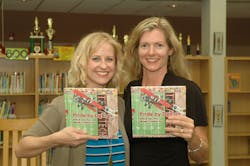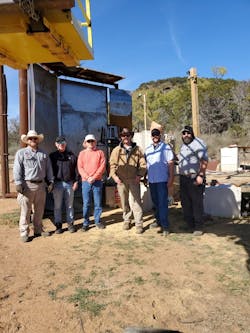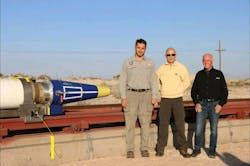Connecting Ideas and Expertise Propels the Future Forward for These Innovators
When Dr. John Granier, chief engineer of munitions and energetics at Element U.S. Space and Defense, and Dr. Michelle Pantoya from Texas Tech University’s Combustion Lab spoke with Machine Design about their collaboration to understand the ignition processes in a range of ammunition systems—from small arms to large tank rounds—to improve the performance and safety of munitions, we knew we had to learn more about what makes these innovators tick.
In their respective journeys, Granier and Pantoya show how diverse backgrounds and insights converge to ignite creativity and drive change in their fields. Their collaboration shows the power of partnership in fostering innovation, and their individual stories illustrate how guidance, curiosity and cross-disciplinary thinking fuels their work and inspires others.
Pantoya’s Path: Guided by Inspiration, Curiosity
Pantoya’s journey to being an innovator began with profound guidance from her mother, who instilled in her a belief that anyone can achieve remarkable things. Growing up in the 1970s amidst the excitement of NASA’s space flights and the moon landing, her mother pointed out that successful individuals were not defined by their gender or ethnicity but rather by their passion for their work.
“She told me that ‘people’ were accomplishing all those exciting things, and since I am a ‘person,’ I could accomplish those things, too,” Pantoya remembers. “She never drew attention to who those people were; she only ever focused on where they were educated, what their professions were and why they were so good at their jobs—because they loved what they did.”
Her mother guided her toward the goal and not to the obstacles that were in her way, she said, “and I think that was all the direction I needed. She taught me to be focused and inspired me to follow the direction that excited me.” This foundational belief became the cornerstone of Pantoya’s pursuit of a career in engineering.
Motivation and Influences
For Pantoya, her students are a constant source of inspiration. Their intellectual curiosity and enthusiasm create an energizing atmosphere that fuels collaboration and creativity. “[The students’] enthusiasm is contagious, so the project itself becomes full of energy and everyone engaged in the project loves it,” she said. “Self-motivated students not only learn a lot, but they also contribute significantly to the research. Often, they even introduce new ways of thinking that can be applied to other projects, thereby benefitting our whole research group.”
A significant aspect of Pantoya’s teaching philosophy is her commitment to instilling critical thinking in her students. She often provides them with resources such as Simon Sinek’s Start with Why, encouraging them to question the underlying motives behind their scientific endeavors. By fostering an environment where asking “why” becomes second nature, she equips her students with the tools to tackle complex challenges and innovate confidently.
Her creative process is organic, often sparked by unexpected moments of clarity that arise when she allows her mind to wander. “New ideas generally come from making connections between different ideas that I’ve been exposed to either through readings, seminars or other project involvement,” she said. “Creativity can’t be forced, but it does tend to mature and develop over time. Sometimes I have my best ideas when I’m walking my dogs—days after initially thinking about potential solutions to a technical problem.”
Legacy and Positive Impact
When asked what advice she would give to aspiring innovators, Pantoya said it is important to keep focused on a vision for the innovation. “Remember your purpose for dedicating your time and energy to the innovation and do not become distracted by ancillary activities or tasks,” she tells her students. “Also, do your best to keep a positive attitude along the way. There will always be obstacles in your path, but if you have an attitude that gets past the obstacles, you can accomplish anything.”
Looking to the future, Pantoya is excited about the potential to harness energy from metal combustion in novel ways. Innovations that enable faster energy release from metal fuels could lead to unprecedented advancements in power generation, opening new avenues for exploration beyond our planet, she said.
“Because power is energy divided by time, greater energy release rates will lead to power generation in quantities never realized in the past,” she explained. “Explosives have about as much energy as a stick of butter on your kitchen table. But they release that energy incredibly quickly, so they demonstrate great power. Metals have exceptionally high energy but release that energy slowly—so, limited power.”
She said they are creating ways that make metals react at time scale more relevant to a detonation and gain energy faster, thereby creating power. “That level of power generation will fuel our way to other planets,” she said. “The potential impact of harnessing metal power is transformative to the future of the human race. That’s exciting!”
Above all, Pantoya hopes to be remembered for the positive impact she has on others’ lives. Witnessing their successes fills her with immense pride and fulfillment.
“My hope is that my impact propagates and influences more lives in a positive way. Helping people make a strong professional start in their life is hugely rewarding for me. Then, watching as their successes build is even more rewarding,” she said.
One of her students, Emily Hunt, is now the dean of Engineering at West Texas A&M. “When [Hunt] started working at WT, there was only a single degree offered in engineering. She created an entire College of Engineering that includes degrees in multiple engineering disciplines,” Pantoya told Machine Design. “She has affected the lives of thousands of people in the West Texas region in a truly positive way by providing them with opportunities to pursue an engineering degree. I am rewarded knowing that I played some role in helping her develop professionally and recognize that she is capable of achieving wonderful things. This is one example of what I mean by influencing an impact that propagates.”
For Pantoya, the true measure of her success lies in the enduring influence she imparts to those she mentors—and another one of her former students and mentees is Dr. John Granier.
Granier’s Gateway: Early Problem Solving to Pursuing Passion
Granier’s early interest in problem-solving set the stage for his innovative career. An introduction to firearms during high school ignited a passion that intersected with his academic pursuits in engineering. “I was first introduced to firearms by a high-school mentor who taught me about hunting and shooting sports. We dove deep into reloading and practiced shooting often,” he said.
This led Granier to explore the field further. “During my undergraduate studies, I was considering going to graduate school for mechanical engineering when I learned that I could dive even deeper into this field by studying nanothermites with an application in green percussion primer for small arms,” noting this was when he knew he wanted to fully commit to this career path. “My graduate studies in reactive materials opened up all sorts of new doors and research areas that allowed me to grow my expertise in not only ballistics, but also in explosives and pyrotechnics.”
A significant turning point in Granier’s career occurred during a conversation with a colleague. Faced with a daunting challenge, his colleague confidently asserted “if a human designed and built it, I can figure it out.” This mindset resonated with Granier and instilled in him a belief that any problem could be approached with diligent research and collaboration, ultimately leading to breakthroughs in his field.
“This was a very confident statement,” Granier said, “but it resonated with me, and I took my colleague’s advice with me into several difficult projects. I felt that any problem that I came across, I could study the background research on that topic and collaborate with scientists in that field to get a thorough understanding of even ‘state-of-the-art’ technology,” adding that once someone has mastered the state-of-the-art, usually there is a natural development of small creative steps to grow an understanding and the solve the next levels of whatever problem lies ahead.
Creative Process and Idea Generation
Granier says that true creativity is a gradual evolution rather than a series of sudden epiphanies. He draws parallels between seemingly unrelated fields, integrating knowledge from a range of disciplines to foster innovative solutions.
For instance, he said, “In physical arts such as painting or science, creativity is seeing the similarity or patterns in dissimilar and nonrelated fields. For example, applying a new type of paint combined with UV (ultraviolet) lighting to create a new effect. Even in this example there was an evolution in the paint industry before the artist could paint, as a scientific thinker first had to have the idea to pulverize UV reflective particles and blend them into a slurry to generate the UV luminescent paint.”
Granier strives to always be learning in hundreds of different interesting fields. “The more technology I can put in my mental database, the more links I can create to reference when I need to solve difficult problems,” he said. “Techniques in cooking food can cross over with adaptation to mixing and blending reactive materials. Equipment that I see in medical imaging at the doctor’s office can also be used to do a detailed inspection of sealed munitions. Sometimes, technology will mature and gain funding through one field, and when it gets well enough established, creative people will see unexplored uses and pull the technology to a totally new and unrelated application.”
Trends and Innovation in Defense
When asked what trends are shaping his industry right now, Granier said that the defense industry is being rapidly pushed forward by additive manufacturing (AM) and artificial intelligence (AI). “I’ve seen many DoD (Department of Defense) research groups pushing the boundaries and materials of additive manufacturing to enable the creation of new materials with higher densities, materials with higher temperature ratings and even more reactive materials,” he said. “These are stretch goals, but the defense community is making progress.”
One DoD application that is close to home for Granier is utilizing AI processing with large amounts of data. “Our computer systems and software are amazingly capable of capturing tons of data,” he said. With AI, humans can quickly find trends and create predictive models based on the data. “A few decades ago, these efforts would have taken so much time that it would have been too inefficient to even consider starting them. Now, we push sensors and diagnostics to the limit with confidence that our engineers (with AI assistance) can analyze it shortly after.”
As for the innovations that Granier is most excited about in his field, he mentioned the significant advancements in visual diagnostic technologies that utilize high-speed video coupled with sophisticated software. Specifically, he notes that scientists are pairing powerful post-processing software with high-speed video to achieve great new insights.
He offers a few examples, including:
- Free-field explosively launched fragment tracking. “Commercial companies are using multiple high-speed cameras in to track fragment velocity and distribution in open air tests,” he said.
- Digital image correlation. “Commercial companies are employing stereoscopic high-speed cameras to measure 3D strain without touching the object of interest, which can sometimes interfere with the measurement,” he explained.
- Digital thermography. “This is more at the research level,” he noted. “Researchers are using special optical filters on conventional digital high-speed cameras. Then through calibration and post-processing software, they can compute 2D temperature maps for really fast events.”
The Influence of Impactful Innovators
The stories of Pantoya and Granier offer great examples of innovation demonstrated by mentorship, curiosity and collaboration. Their dedication to advancing environments where inquiry reigns not only elevates their personal work but inspires the next generation of innovators.
As they continue to push boundaries and explore new frontiers, their insights are a great reminder that innovation is as much about the connections we make and the lives we influence as it is about the outcomes we achieve. Through their journeys, we learn that the path to innovation is not just a destination but an ongoing experience of growth, exploration and impact.
WATCH: The Role of Advanced Sensors in Propellant Technology
Editor’s Note: Machine Design’s WISE (Workers in Science and Engineering) hub compiles our coverage of workplace issues affecting the engineering field, in addition to contributions from equity seeking groups and subject matter experts within various subdisciplines.
About the Author
Sharon Spielman
Technical Editor, Machine Design
As Machine Design’s technical editor, Sharon Spielman produces content for the brand’s focus audience—design and multidisciplinary engineers. Her beat includes 3D printing/CAD; mechanical and motion systems, with an emphasis on pneumatics and linear motion; automation; robotics; and CNC machining.
Spielman has more than three decades of experience as a writer and editor for a range of B2B brands, including those that cover machine design; electrical design and manufacturing; interconnection technology; food and beverage manufacturing; process heating and cooling; finishing; and package converting.
Email: [email protected]
LinkedIn: @sharonspielman
Facebook: Machine Design
YouTube: @MachineDesign-EBM








